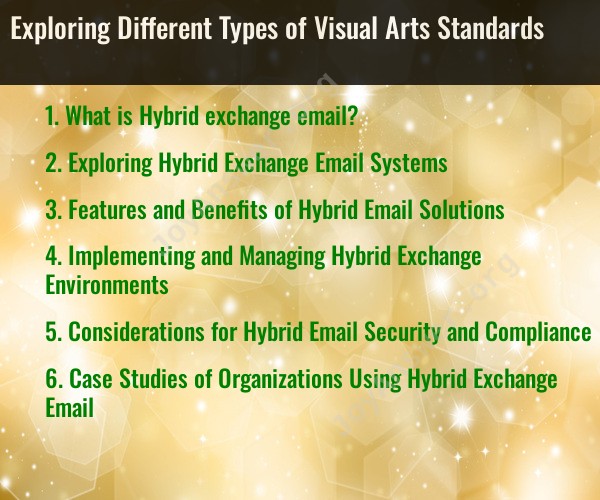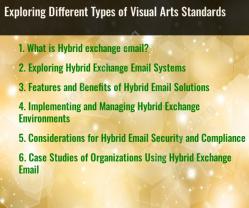What is Hybrid exchange email?
A "Hybrid Exchange email" typically refers to a configuration in which an organization uses a combination of on-premises Microsoft Exchange Server and Microsoft 365 (formerly known as Office 365) for their email and messaging services. This hybrid setup allows for a seamless integration of email services, enabling some mailboxes to be hosted on the organization's local Exchange Server while others are hosted in the cloud on Microsoft 365.
Here are the key components and features of a Hybrid Exchange email configuration:
On-Premises Exchange Server: In a hybrid configuration, the organization maintains an on-premises Exchange Server. This server is responsible for managing some of the organization's email accounts, typically for legacy or specific use cases.
Microsoft 365 (Office 365) Cloud: The organization also utilizes Microsoft 365 (or Office 365) for hosting email accounts. Microsoft 365 is a cloud-based suite of productivity and collaboration tools, including Exchange Online, which provides cloud-hosted email services.
Coexistence: The hybrid configuration allows for coexistence between the on-premises Exchange Server and Exchange Online. Users with mailboxes on both platforms can continue to send and receive emails seamlessly.
Single Sign-On (SSO): With appropriate configuration, users can access their mailboxes on both the on-premises server and Exchange Online without needing separate usernames and passwords. Single Sign-On (SSO) enables users to sign in once to access both systems.
Mailbox Migration: Organizations can migrate mailboxes from the on-premises Exchange Server to Exchange Online in the cloud, and vice versa. This allows for a phased migration approach or ongoing maintenance.
Shared Calendar and Free/Busy Information: Users in a hybrid environment can access shared calendars and free/busy information, even when their mailboxes are on different platforms.
Global Address List (GAL) Synchronization: A hybrid setup typically synchronizes the Global Address List (GAL) between the on-premises Exchange Server and Exchange Online to ensure consistency and easy contact lookup.
Message Routing: Mail flow is configured to ensure that emails are routed correctly between the on-premises and cloud-based mailboxes. Inbound and outbound messages are directed through the appropriate system.
A hybrid Exchange email configuration is commonly used by organizations during a transition from on-premises Exchange Server to Microsoft 365. It provides flexibility and allows businesses to move to the cloud at their own pace, accommodating specific business needs or compliance requirements.
Setting up and managing a hybrid Exchange environment can be complex, and it often requires careful planning, configuration, and administration. Many organizations seek the assistance of IT professionals or consultants experienced in hybrid Exchange setups to ensure a smooth and secure transition.
Exploring Hybrid Exchange Email Systems
A hybrid email system combines the on-premises functionality of Microsoft Exchange Server with the cloud-based features of Microsoft 365 or Office 365. This approach allows organizations to leverage the benefits of both platforms, providing flexibility, security, and cost-effectiveness.
Features and Benefits of Hybrid Email Solutions
Hybrid email solutions offer several advantages over traditional on-premises or cloud-based deployments:
Flexibility: Organizations can maintain control over sensitive data on-premises while utilizing cloud-based features like Exchange Online Archiving and Azure Active Directory.
Security: Hybrid deployments allow for granular control over data access and security policies, ensuring compliance with industry regulations.
Cost-effectiveness: Organizations can optimize their IT budget by scaling cloud services based on their needs while maintaining existing on-premises infrastructure.
Reduced migration complexity: A hybrid approach enables a phased migration to the cloud, minimizing disruptions and allowing for a controlled transition.
Implementing and Managing Hybrid Exchange Environments
Implementing and managing hybrid Exchange environments requires careful planning and consideration:
Infrastructure assessment: Evaluate the existing on-premises infrastructure and its compatibility with cloud services.
Deployment planning: Design the hybrid architecture, including connectivity, synchronization, and security configurations.
Identity management: Integrate on-premises Active Directory with Azure Active Directory to manage user accounts and permissions.
Mail flow configuration: Configure mail flow rules to ensure seamless delivery between on-premises and cloud mailboxes.
Monitoring and troubleshooting: Establish monitoring tools and procedures to identify and resolve potential issues promptly.
Considerations for Hybrid Email Security and Compliance
Security and compliance are paramount in hybrid email environments:
Data encryption: Encrypt data at rest and in transit to protect sensitive information.
Access control: Implement strong access control policies to restrict unauthorized access to data and resources.
Threat protection: Employ advanced threat detection and prevention solutions to safeguard against malware, phishing attacks, and other cyber threats.
Compliance audits: Conduct regular compliance audits to ensure adherence to industry regulations and data privacy laws.
Case Studies of Organizations Using Hybrid Exchange Email
Numerous organizations have successfully implemented hybrid Exchange email solutions to achieve their business goals:
A large retail company: Hybrid Exchange allowed the company to migrate a portion of its mailboxes to the cloud while maintaining compliance and security for sensitive customer data.
A global healthcare organization: Hybrid Exchange enabled the organization to scale its email infrastructure to support a growing employee base while maintaining stringent data privacy standards.
A financial services firm: Hybrid Exchange provided the flexibility to meet regulatory requirements and maintain granular control over email security while utilizing cloud-based features for improved collaboration.
These case studies demonstrate the versatility and value of hybrid Exchange email solutions in addressing the diverse needs of organizations across various industries.



